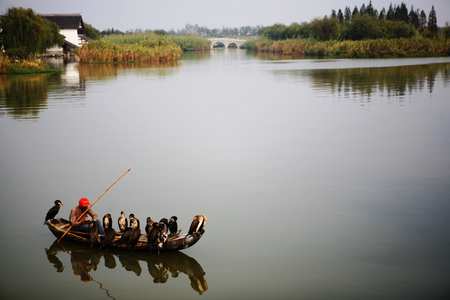China's melodious past
|
|
|
A fishing boat with cormorants. Photos: IC |
Shajiabang is a village near Changshu in Jiangsu Province approximately two hours from Shanghai. It's a sleepy backwater, but a great deal of investment has resulted in the construction of a tourist area which promises a relaxing and surprisingly interesting look at traditional Chinese culture. A day at Shajiabang gives visitors a chance to sample local cuisine and drinks, listen to traditional folk music and Peking Opera and enjoy a boat ride through the high reeds of a neighboring marsh.
An opera's backdrop
Most Chinese are familiar with the town as a result of the Peking Opera of the same name which came to prominence during the Cultural Revolution (1966-1976). The opera tells the story of A'Qingsao, a local woman who ran a tea house in Shajiabang during the time of China's war with Japan. During this time, the New Fourth Army suffered significant casualties. When they retreated to Shajiabang, A'Qingsao came to their aid, giving the army refuge in the marshland of Shajiabang while the Japanese looked for them. After the flight of the Red Army, A'Qingsao also proved instrumental in exposing Diao Deyi, a Japanese double agent and revealing the Japanese's plan of attack, an act that eventually allowed the Chinese to defeat the Japanese.
Although this nationalist tale of Chinese struggle against Japanese oppression may not resonate readily with most foreigners, it does result in the spectacle of watching face-painted men dressed in vintage army uniforms wail in the distinctive Peking Opera style. It's a sight not to be missed.
Ye olde China
Unlike many other scenic villages in the Shanghai area, Shajiabang's traditional Hengjing Street isn't clogged with vendors hawking cheap goods. There is a real working blacksmith, a distillery making baijiu and plum wine, and a shop selling zongzi, glutinous rice cakes wrapped in reed leaves from the local marsh.
On the way be sure to take a look at the Countryside Customs Museum. It's a bit kitschy, but makes for a good photo opportunity. Put your best face on and grab a picture next to a statue of someone in an antique kitchen or sorting through a series of fishing nets.
Walking down the street, you may run into a troupe of female singers, all in matching blue uniforms singing traditional songs. The songs follow the pattern of some traditional ancient Greek choruses, with a single member calling out a solo refrain that is then echoed by the throng of women around her. The songs are sung in the local dialect, making them incomprehensible to anyone not from the area. When asked what the songs meant, one of the women responded that they were once sung while working in the fields, and that they told stories of women hoping for a good harvest and a long life.
 0
0 









Go to Forum >>0 Comments